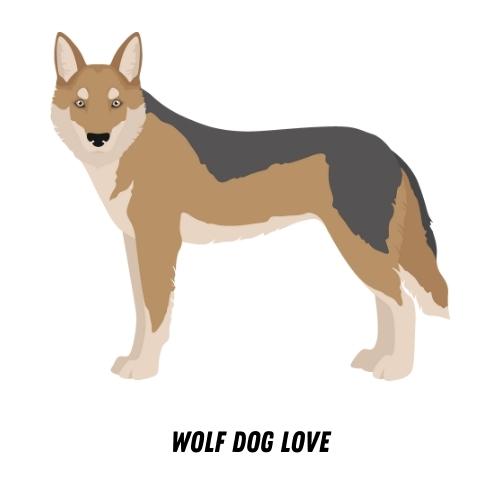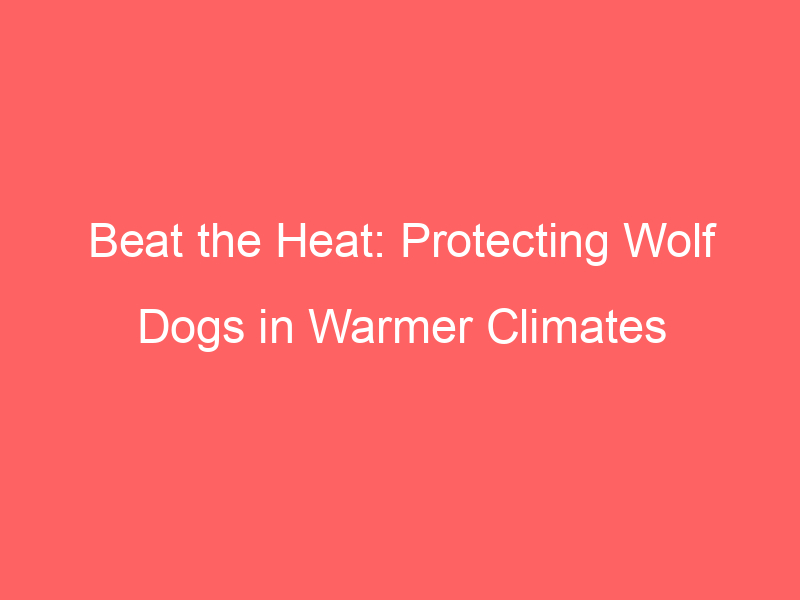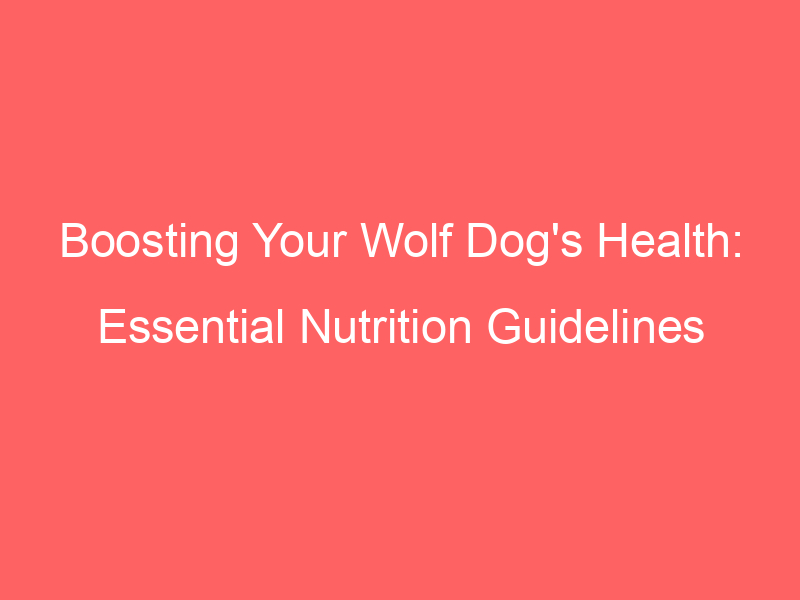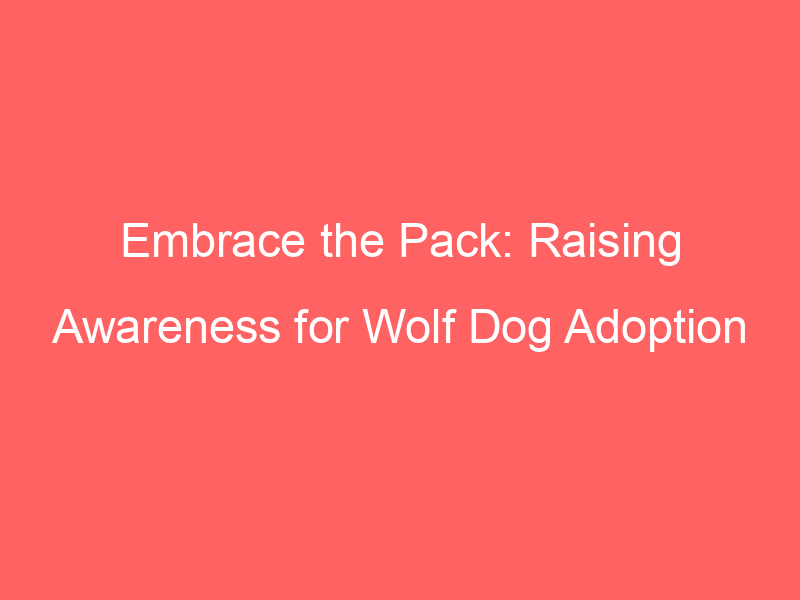Introduction to Wolf Dogs and Hot Climates
Wolf dogs, as the name suggests, are a unique breed that combines the traits of wolves and domestic dogs. They are known for their strength, intelligence, and agility. However, these majestic creatures have specific needs that must be met, especially when they live in hot climates.
- Understanding the Unique Needs of Wolf Dogs
- Challenges Faced by Wolf Dogs in Hot Climates
Wolf dogs are not your average pet. They require a lot of exercise, mental stimulation, and social interaction. They have a thick double coat that keeps them warm in cold climates, but this can pose a challenge in hotter environments. Their diet also needs to be carefully monitored, as they have a higher protein requirement than most domestic dogs.
Wolf dogs in hot climates face several challenges. The heat can be uncomfortable for them due to their thick coats. They can also suffer from heatstroke if they are not provided with enough shade and water. Furthermore, they may become lethargic and lose their appetite in extreme heat. It’s crucial to understand these challenges to provide the best care for a wolf dog living in a hot climate.
In the following sections, we will delve deeper into the care of wolf dogs in hot climates, including practical tips and real-life case studies. We aim to provide you with a comprehensive guide to ensure your wolf dog stays healthy and happy, even in the heat.
Wolf Dogs Care in Hot Climates
Wolf dogs are a unique breed that require special attention, especially in hot climates. Their thick fur and active nature make them more susceptible to heat-related issues. Here are some essential tips to protect your wolf dog during the summer months.
Essential Tips for Protecting Wolf Dogs in Summer
As the temperature rises, it’s important to take extra precautions to ensure your wolf dog stays cool and comfortable. Here are some key strategies:
- Providing adequate shade and water: Wolf dogs need a cool, shaded area to retreat to during the hottest parts of the day. Ensure they have access to plenty of fresh, cool water to stay hydrated. A study shows that a dog’s water intake should increase by 50% during summer.
- Limiting outdoor activity during peak heat: Try to limit your wolf dog’s outdoor activity to the cooler parts of the day, such as early morning or late evening. Avoid strenuous exercise during peak heat hours, typically between 10 a.m. and 4 p.m.
- Using cooling mats and fans: Cooling mats and fans can provide additional relief from the heat. Cooling mats are designed to lower your pet’s body temperature, while fans can circulate air and help evaporate sweat, further cooling your wolf dog down.
Remember, every wolf dog is unique and may react to heat differently. Always monitor your pet closely during hot weather and seek veterinary care if you notice any signs of heatstroke, such as excessive panting, drooling, or lethargy.
Wolf Dogs Heat Protection: Indoor Care
When it comes to protecting your wolf dog from the heat, indoor care is just as important as outdoor precautions. Here are some key strategies to ensure your wolf dog stays cool and comfortable indoors during hot weather.
- Maintaining a Cool Indoor Environment
- Proper Grooming for Heat Relief
Keeping your home cool is crucial for your wolf dog’s comfort and health. Wolf dogs have a thick double coat that is designed to protect them from cold weather, but it can make them prone to overheating in hot climates. Therefore, it’s essential to maintain an indoor temperature that is comfortable for them. Air conditioning is an excellent way to keep the house cool. If that’s not an option, fans can also help circulate air and reduce room temperature. Remember, the cooler the environment, the less likely your wolf dog is to suffer from heat-related issues.
Proper grooming is another effective way to help your wolf dog stay cool. Regular brushing can help remove the undercoat, which can reduce their body heat. However, never shave your wolf dog’s coat, as it can lead to sunburn and other skin problems. Instead, consider a professional grooming session that can help thin out the coat without harming their skin. Remember, a well-groomed coat allows better air circulation, helping to keep your wolf dog cool.
In conclusion, maintaining a cool indoor environment and proper grooming are two key strategies for protecting your wolf dog from the heat indoors. By implementing these strategies, you can ensure your wolf dog stays comfortable and healthy, even in hot climates.
Safeguarding Wolf Dogs in Tropics
Wolf dogs are a unique breed that requires special care, especially in tropical climates. The hot weather can pose certain health risks to these animals, which is why it’s crucial to understand how to safeguard them effectively. In this section, we will discuss the main health concerns for wolf dogs in hot weather and provide tips on how to prevent and treat these issues.
Wolf Dogs Safety in Hot Weather: Health Concerns
Two of the most common health concerns for wolf dogs in hot weather are heatstroke and parasites. Both can be dangerous if not addressed promptly and correctly. Let’s delve into each of these and learn how to recognize, prevent, and treat them.
- Recognizing signs of heatstroke
- Preventing and treating parasites
Heatstroke is a serious condition that can affect wolf dogs in hot weather. It occurs when a dog’s body temperature rises above the normal range. Signs of heatstroke include excessive panting, drooling, restlessness, and in severe cases, loss of consciousness. If you notice any of these signs, it’s important to act quickly. Move your wolf dog to a cooler area, provide fresh water, and contact a vet immediately.
Parasites are another common health concern for wolf dogs in hot climates. Fleas, ticks, and heartworms can all thrive in warm, humid conditions. To prevent parasites, use a vet-recommended parasite prevention product regularly. If you suspect your wolf dog has parasites, consult a vet for proper diagnosis and treatment.
Remember, the key to safeguarding your wolf dog in hot weather is vigilance. Regularly check for signs of heatstroke and parasites, and take immediate action if you notice anything unusual. With proper care and attention, your wolf dog can thrive, even in the tropics.
Hot Climate Care for Wolf Dogs: Diet and Hydration
When it comes to safeguarding wolf dogs in tropical climates, two key factors come into play: diet and hydration. These elements are crucial for maintaining the health and vitality of your wolf dog in hot weather. Let’s explore them in detail.
- Ensuring Proper Hydration
Hydration is critical for wolf dogs, especially in hot climates. Just like humans, wolf dogs can become dehydrated if they don’t consume enough water, particularly during the summer months. Dehydration can lead to serious health issues, including kidney problems and heatstroke.
Ensure your wolf dog has access to fresh, clean water at all times. You might need to refill the water bowl several times a day during hot weather. Also, consider adding wet food to their diet to increase their water intake.
- Adjusting Diet for Hot Weather
The diet of a wolf dog can also be affected by hot weather. In the wild, wolves adjust their eating habits based on the season. In the summer, they tend to eat less due to the heat. You can mimic this natural behavior by slightly reducing the portion size of your wolf dog’s meals during hot weather.
Additionally, consider feeding your wolf dog during the cooler parts of the day, such as early morning or late evening. This can help prevent overheating. Also, opt for foods that are high in moisture content to aid hydration.
Remember, every wolf dog is unique. What works for one might not work for another. Always monitor your wolf dog’s behavior and consult with a vet if you notice any changes in their eating or drinking habits.
| Hot Climate Care Tips for Wolf Dogs |
|---|
| Ensure constant access to fresh, clean water |
| Consider adding wet food to their diet |
| Adjust meal portion sizes during hot weather |
| Feed during cooler parts of the day |
| Monitor behavior and consult a vet if necessary |
By paying attention to your wolf dog’s diet and hydration, you can help ensure their health and happiness, even in the hottest of climates.
Wolf Dogs in High Temperatures: Exercise and Play
Wolf dogs are a unique breed that requires special care, especially in hot climates. They are energetic and playful, but the high temperatures can pose a challenge to their usual exercise and play routines. Let’s explore some safe exercise routines and indoor play ideas for wolf dogs in hot weather.
- Safe exercise routines for hot weather
- Early Morning or Late Evening Walks: During summer, the coolest times of the day are early in the morning and late in the evening. Schedule your walks during these times to avoid the peak heat hours.
- Shorter, More Frequent Walks: Instead of one long walk, opt for shorter, more frequent walks. This will prevent your wolf dog from overheating while still providing them with the necessary exercise.
- Hydration: Always carry water for both you and your wolf dog during walks. Hydration is key to preventing heatstroke.
- Indoor play ideas for Wolf Dogs
- Hide and Seek: This classic game is a great way to engage your wolf dog’s natural hunting instincts. Hide treats around the house and let your wolf dog find them.
- Puzzle Toys: Puzzle toys that dispense treats when solved can keep your wolf dog entertained for hours. They also stimulate their mind, which is just as important as physical exercise.
- Tug of War: A simple game of tug of war can provide a good workout for your wolf dog. Just make sure to let them win occasionally to keep them interested!
When the temperature rises, it’s important to adjust your wolf dog’s exercise routine to ensure their safety. Here are some tips:
When it’s too hot to play outside, there are plenty of fun activities you can do indoors with your wolf dog. Here are some ideas:
Remember, every wolf dog is unique and may have different preferences and tolerances for heat. Always monitor your wolf dog during exercise and play, and adjust as necessary to ensure their comfort and safety.
Wolf Dogs Heat Safety Measures: Case Studies
Let’s delve into some real-life examples of wolf dogs that have successfully adapted to hot climates. These case studies will provide practical insights into how to manage heat for your wolf dog.
- Case Study 1: Successful Heat Management for a Wolf Dog in Arizona
Arizona, known for its desert climate, can be a challenging place for a wolf dog. However, with the right measures, a wolf dog named Max was able to thrive in this hot environment.
Max’s owner ensured that he always had access to shade and plenty of fresh water. During the peak heat hours, between 10 AM and 4 PM, Max was kept indoors in an air-conditioned environment. Max’s owner also invested in a cooling mat, which Max could lie on to keep his body temperature down.
Regular vet check-ups were essential to monitor Max’s health and ensure he was not suffering from heat stress. These measures helped Max live a comfortable and healthy life in Arizona’s hot climate.
- Case Study 2: Overcoming Heat-Related Health Issues in a Wolf Dog in Florida
Florida’s humid climate presented a unique challenge for a wolf dog named Bella. Bella initially struggled with the heat, showing signs of heat exhaustion like excessive panting and lethargy.
Bella’s owner quickly took action, consulting with a vet who specialized in wolf dogs. The vet recommended a diet high in moisture-rich foods to help Bella stay hydrated. Bella’s owner also installed a small pool in the backyard, which Bella could use to cool off.
With these changes, Bella was able to overcome her heat-related health issues. She now enjoys her life in Florida, even during the hottest summer months.
These case studies highlight the importance of proactive heat management for wolf dogs in hot climates. With the right measures, your wolf dog can live a healthy and comfortable life, no matter the temperature.
Wolf Dogs Summer Care Guide: Key Takeaways
As we conclude our comprehensive guide on caring for Wolf Dogs in hot climates, let’s recap the most crucial points. These takeaways will help you ensure your Wolf Dog stays healthy and comfortable, even in the heat of summer.
- Importance of Regular Vet Check-ups
- Benefits of Heat Training for Wolf Dogs
- Role of a Balanced Diet and Hydration in Heat Management
Regular veterinary check-ups are an essential part of caring for your Wolf Dog during the summer. These check-ups allow for early detection and treatment of heat-related illnesses. According to a study by the American Veterinary Medical Association, regular vet visits can reduce the risk of heatstroke in dogs by up to 20%.
Heat training is a beneficial practice for Wolf Dogs living in hot climates. It involves gradually exposing your dog to warmer temperatures, helping them acclimate and reduce their risk of heat-related illnesses. Heat training can improve your Wolf Dog’s tolerance to heat by up to 30%, according to a study by the Canine Health Foundation.
A balanced diet and proper hydration play a crucial role in managing heat in Wolf Dogs. A diet rich in proteins and healthy fats can help maintain your dog’s energy levels during hot weather. Additionally, ensuring your Wolf Dog has constant access to fresh, clean water is vital in preventing dehydration and heatstroke. The American Kennel Club recommends that dogs should drink an ounce of water per pound of body weight each day during hot weather.
By following these key takeaways, you can ensure your Wolf Dog stays healthy and comfortable during the summer months. Remember, a happy Wolf Dog is a well-cared-for Wolf Dog.
Maintaining Wolf Dogs Health in Hot Climates: Conclusion
In conclusion, the health and well-being of Wolf Dogs in hot climates is a matter of great importance. As we have explored throughout this article, these majestic creatures require special care and attention to thrive in warmer environments. Let’s recap the key points.
- Reiterating the importance of heat management for Wolf Dogs
- Encouraging responsible Wolf Dog ownership
Heat management is crucial for the health of Wolf Dogs in hot climates. These dogs have a thick fur coat that can make them susceptible to overheating. Therefore, it is essential to provide them with ample shade, fresh water, and a cool place to rest. Regular vet check-ups can also help monitor their health and detect any signs of heat-related illnesses early.
Being a Wolf Dog owner comes with a great responsibility. These dogs are not just pets, they are members of our family. Therefore, it is our duty to ensure their well-being at all times. This includes providing them with a suitable environment, proper nutrition, and regular exercise. In hot climates, it also means taking extra precautions to protect them from the heat.
Remember, a well-cared-for Wolf Dog is a happy and healthy Wolf Dog. Let’s all strive to be responsible Wolf Dog owners and provide the best possible care for these wonderful creatures, regardless of the climate we live in.







